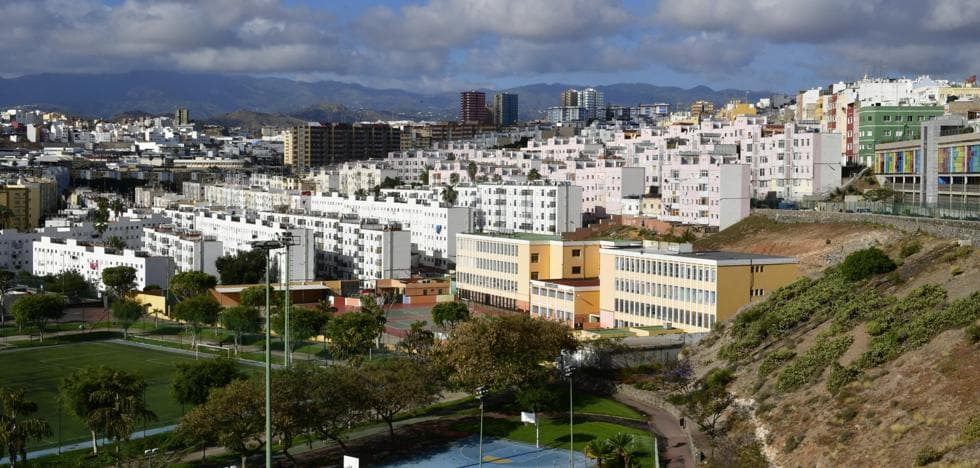The cartography of altercations related to migrants in recent weeks has had Las Rehoyas as the axis of conflicts in the district of Ciudad Alta, in Las Palmas de Gran Canaria. Street brawls, protests outside the curfew and the appearance of an inflamed speech that has taken part of its streets. This context coincides with the presence at CAAM, as part of the collective ‘In / Out: A possible map’, which can be visited until next March 7, of ‘Neighborhood Pride’. A work signed by the artistic collective PSJM and that has as its centerpiece the video shot and focused on the neighborhood of the song by rapper Alberto Gekah with the collaboration of Asiria Álvarez.
It is about explaining the neighborhood through art. With a participatory construction of the discourse and unpleasant rhymes by Gekah. People at the center of the debate, looking for the context for a nucleus of more than 2,500 families “under the Ship, between El Polvorín and the Polígono.”
This citizen participation project concluded just in the last months of last year, conditioned by the pandemic but carried out on the ground. Without having in the creative imaginary of its promoters that the situation was going to be affected in such a way only a few months later. «We promoted the action but the participation part was being carried out by Gekah and Asiria, who are also neighbors of Las Rehoyas. With which they were much more integrated. It worked very well. Talk about the things you can be proud of but also about the miseries of the neighborhood. The song is not at all complacent. It is true that the situation we are in is very delicate. Because it is being used by the extreme right to bring out the worst in people. And it is in popular neighborhoods where they can mobilize it because it is where they are most affected, “says Pablo San José, a member of PSJM with Cynthia Viera.
Gekah signs a remarkable portrait of the reality of the neighborhood in which he grew up and forged an identity. A place where “stories have been told, sometimes badly and sometimes half”. During the four minutes of the song, he goes on phrases about the daily life of those streets, about their popular characters or the relationship with small businesses. But also for those houses, now in the replacement phase, of 50 square meters that more than “houses look like tool rooms.”
Pablo San José believes that among all the shortcomings and institutional neglect of places like Las Rehoyas, it is necessary to underline the invisibility that the system often offers these neighbors. Just what they intend to change with this initiative. “In all these types of participatory projects there is the hope that we can grow and reach a better world. Make microutopias, act in a very local way where you can change something. That is not without a certain naivety, because you find everything. One of the great issues of these neighborhoods, with all the needs they have, which cry out to heaven, is simply that they listen to them. That you count on them. That is the question that can give dignity to the neighborhood. Therefore it is true that we make art and there is an aesthetic component in which we seek a balance between the amateurism of every human being to create things and us redirect it from our technical condition to try to make things improve in the place, “he stresses.
Social construction.
PSJM stands out for the social outlook of its work. This artistic collective, in addition to consolidating an international projection of its work for decades, has also developed participatory projects in other neighborhoods of the city, such as Hoya de La Plata. Piece that can also be visited at ‘In / Out’.
Attentive to a situation in which he perceives “a disastrous management of the central government” in immigration policy, Pablo San José understands that this is a trigger for the “revolt” of these days. That it has an origin not too far from the material with which they carved their work. “There is a question, for better or for worse. And it is that one of the engines for participation is outrage. That was clear to us when people took to the streets in 2011 or when we do these processes. And that can be conveyed or towards the good intentions of improve the neighborhood with respect, creating citizenship or the opposite. What is happening now. Because it is very easy to pull people’s guts out, ”he emphasizes.
Las Rehoyas is a «neighborhood of workers and unemployed; same accent and different voice ”, as Gekah sings. An urban space subjected to a transformation process that cannot be constrained to viral videos of a protest street. There is a lot of roots and a melting pot of personalities, which needs a wider study space to get closer to its understanding. That is what he tries to transfer from an artistic dissection that perfectly understands that substrate because it drinks from those streets.
– .


